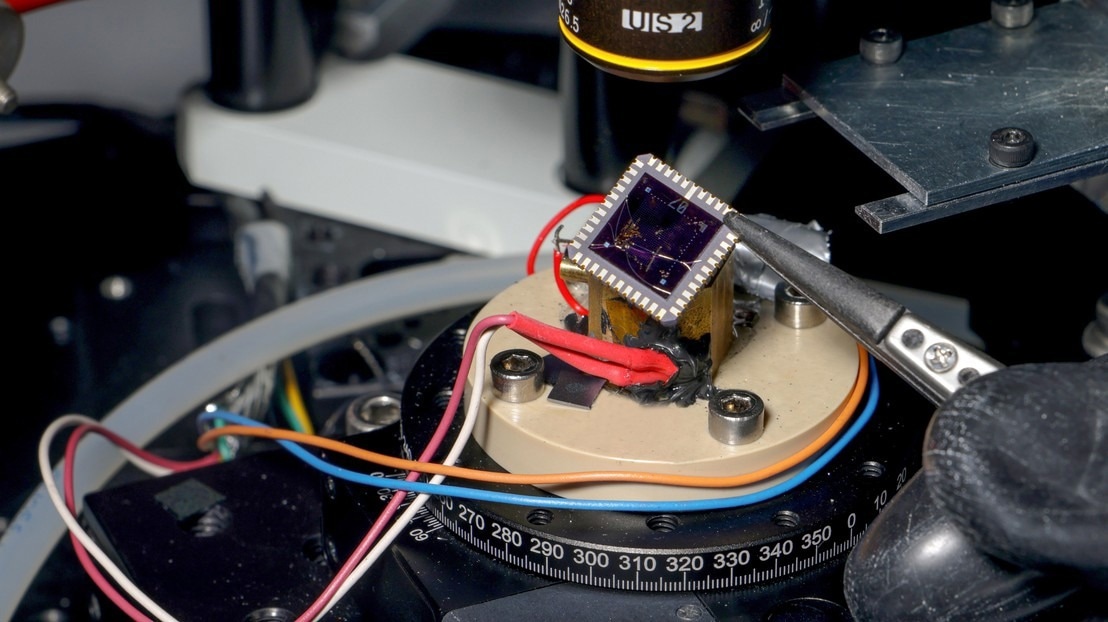Engineers from the EPFL Laboratory of Nanoscale Electronics and Structures have developed a gadget that effectively converts heat into electrical voltage at extremely low temperatures and with an efficiency that is on par with existing room temperature technologies. This discovery could help remove a major barrier to the development of quantum computer systems, which depend on very low temperatures for optimal operation.
 The LANES lab's 2D device is made of graphene and indium selenide. Image Credit: ©Alain Herzog
The LANES lab's 2D device is made of graphene and indium selenide. Image Credit: ©Alain Herzog
Quantum computations require quantum bits (qubits) to be cooled to millikelvin temperatures (near -273 Celsius) to reduce atomic motion and minimize noise. However, the electronics that control these quantum circuits produce heat, which is difficult to dissipate at such low temperatures.
Consequently, most current technologies must separate quantum circuits from their electronic components, resulting in noise and inefficiencies that obstruct the development of larger quantum systems outside the laboratory.
We are the first to create a device that matches the conversion efficiency of current technologies, but that operates at the low magnetic fields and ultra-low temperatures required for quantum systems. This work is truly a step ahead.
Gabriele Pasquale, Ph.D. Student, Swiss Federal Institute of Technology Lausanne
The novel device combines indium selenide's semiconductor qualities with graphene's superior electrical conductivity. Its exceptional performance comes from a unique combination of materials and structure, and although being only a few atoms thick, it behaves like a two-dimensional entity.
Harnessing the Nernst Effect
The device leverages the Nernst effect, a complex thermoelectric phenomenon that produces an electrical voltage when a magnetic field is applied perpendicular to an object with a temperature gradient. The two-dimensional structure of the lab’s device enables electrical control over the efficiency of this mechanism.
The 2D structure was fabricated at the EPFL Center for MicroNanoTechnology and the LANES lab.
Experiments utilized a laser as a heat source and a specialized dilution refrigerator to achieve temperatures as low as 100 millikelvin, which is colder than outer space. Converting heat to voltage at such low temperatures is typically very challenging. However, the novel device, by harnessing the Nernst effect, makes this possible, addressing a crucial gap in quantum technology.
If you think of a laptop in a cold office, the laptop will still heat up as it operates, causing the temperature of the room to increase as well. In quantum computing systems, there is currently no mechanism to prevent this heat from disturbing the qubits. Our device could provide this necessary cooling.
Gabriele Pasquale, Ph.D. Student, Swiss Federal Institute of Technology Lausanne
Pasquale, a Physicist by background, highlights that this study is important since it clarifies thermopower conversion at low temperatures, a phenomenon that has received little attention up until now.
The LANES team also thinks that their device might already be integrated into existing low-temperature quantum circuits because of its high conversion efficiency and utilization of potentially manufactured electronic components.
These findings represent a major advancement in nanotechnology and hold promise for developing advanced cooling technologies essential for quantum computing at millikelvin temperatures. We believe this achievement could revolutionize cooling systems for future technologies.
Gabriele Pasquale, Ph.D. Student, Swiss Federal Institute of Technology Lausanne
Journal Reference:
Pasquale, G., et al. (2024) Electrically tunable giant Nernst effect in two-dimensional van der Waals heterostructures. Nature Nanotechnology. doi.org/10.1038/s41565-024-01717-y.